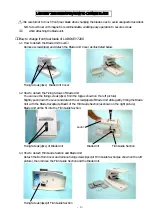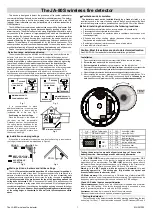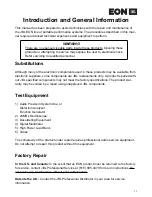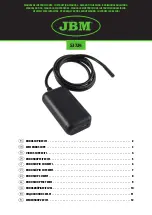
12
4. You are now ready to adjust the levels. Select a preset
using the MIDI footswitch or front panel controls. If the level
is too high or too low, adjust it by stepping on the footswitch. Repeat for all presets that need adjusting.
5. When finished, turn the Preset Manager back on so accidental re-programming doesn’t occur.
The remote Adjust routine has a special “self limiting” feature built in that prevents the “mix” of several connections going to
the final output from changing with respect to each other. In other words, if 3 connections go to the output and the gains of
each connection are -12dB, -6dB, and -3dB, then the output can be increased until the connection with the highest gain (-3dB)
reaches the highest possible gain (0dB). At that point further increases are ignored since the mix would then begin to change.
Likewise, the output can be decreased until the connection with the lowest gain (-9dB) reaches the lowest possible gain
(-48dB). This self limiting action insures that regardless of how far an output is adjusted, it can always be returned to the
original program just by stepping on the opposite switch.
The Remote Adjust routine does not change any connections that are programmed with continuous control (i.e. a connection
that has both a “start” gain and an “end” gain), even if the connection is connected to a “selected” output.
BACKUP FUNCTIONS: (SETUP MENU GROUP)
This menu is used to save all preset, setup, and preset manager programs to either a standalone sequencer, a sys-ex dump
device, or a computer based sequencer. To use this menu:
1. Be sure that a MIDI cable is connected from the MIDI OUT/THRU on the Switchblade to the MIDI in on the sequencer,
and another from the MIDI IN on the Switchblade to the MIDI OUT on the sequencer. Set the sequencer filters to transmit
and receive SYSTEM EXCLUSIVE (SYS-EX) information. All other filters (POLY, PITCH, NOTES etc) can be set to off.
Set the internal clock active on the sequencer and the tempo to maximum. Turn off the lead in function. If the length is not
automatic, set the length to 20 measures or so.
2. To save all preset data, move the cursor under "SAVE", start the sequencer to record, and press UP/DOIT. NOTE: BE
SURE TO START THE SEQUENCER RECORDING BEFORE PRESSING UP/DOIT.
3. After the SAVE IN PROGRESS message goes back to BACKUP FUNCTIONS (about 10 seconds), then you will want to
verify the information for and reset the sequencer to the first measure. Press the UP/DOIT switch so the message VERIFY IN
PROGRESS is displayed, then press the play button on the sequencer. NOTE: BE SURE TO START THE SEQUENCER
PLAYBACK AFTER THE UP/DOIT SWITCH IS PRESSED. If the verify is successful the display will go back to BACKUP
FUNCTIONS. If it was not successful then an error message will be displayed.
4. To restore program information from a sequencer to the Switchblade, select "RESTORE". Reset the sequencer to the first
measure. Press the UP/DOIT switch so the message "LOAD IN PROGRESS" is displayed, then press the play button on the
sequencer. NOTE: BE SURE TO PRESS THE UP/DOIT BEFORE STARTING THE SEQUENCER. When the load is
complete, the display will return to "BACKUP FUNCTIONS". If an error occurred during load an error message will be
displayed.
CONTROL OUTPUT CONFIGURATION MENU: (SETUP MENU GROUP)
The control output ports on the back of the switchblade are connected to 2 relays through 2 jacks. These ports can be used to
take the place of either the push on/push off types of switches or a momentary push on/release off type of switch that normally
connect to most amplifiers and some effect devices that have a "footswitch" input. The Switchblade control ports can be
configured as either type of switch through this menu. In most cases, amplifiers like to see a "steady state" type of control
signal such as on or off. This is identified as an "S" in this menu. Some effect devices and amplifiers prefer to see a "pulse"
on the line, which would be similar to a momentary switch. This is identified as a "P" in this menu.
To use this menu:
1. First move the cursor under the number of the control output you want to configure. I.e. "1" is for control output #1 and so
on.
2. To configure a control output to look like a "push on/push off" type of switch, press the UP/DOIT switch so the selected
output number changes to the letter "S" for "Steady state".
3. To configure a control output to look like a momentary "push on/release off" type of switch, press the UP/DOIT switch so
the selected output number changes to the letter "P" for "Pulse".
Содержание Switchblade 8B
Страница 1: ...OWNER S MANUAL Document OM8B0905 ...








































